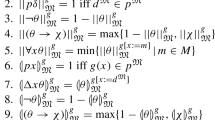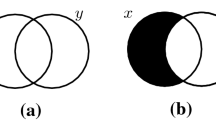Abstract
Different natural deduction proof systems for intuitionistic and classical logic —and related logical systems—differ in fundamental properties while sharing significant family resemblances. These differences become quite stark when it comes to the structural rules of contraction and weakening. In this paper, I show how Gentzen and Jaśkowski’s natural deduction systems differ in fine structure. I also motivate directed proof nets as another natural deduction system which shares some of the design features of Genzen and Jaśkowski’s systems, but which differs again in its treatment of the structural rules, and has a range of virtues absent from traditional natural deduction systems.
Similar content being viewed by others
References
Anderson, A. R., and N. D. Belnap. Entailment: The Logic of Relevance and Necessity, volume 1. Princeton University Press, Princeton, 1975.
Anderson, A. R., N. D. Belnap, and J. M. Dunn. Entailment: The Logic of Relevance and Necessity, volume 2. Princeton University Press, Princeton, 1992.
Belnap N. D.: Display Logic. Journal of Philosophical Logic 11, 375–417 (1982)
Curry, H. B., Foundations of Mathematical Logic. Dover, 1977. Originally published in 1963.
Došen, K., The first axiomatization of relevant logic. Journal of Philosophical Logic 21(4):339–356, November 1992.
Dunn J. M., and G. Restall. Relevance Logic. In D. M. Gabbay, (ed.), Handbook of Philosophical Logic, volume 6. Kluwer Academic Publishers, Second edition, 2002, pp. 1–136.
Fitch, F. B., Symbolic Logic. Roland Press, New York, 1952.
Gentzen, G., Untersuchungen über das logische Schliessen. Math. Zeitschrift 39, 1934.
Gentzen G.: Die Widerspruchsfreiheit der reinen Zahlentheorie. Mathematische Annalen, 112, 493–565 (1936)
Girard J.-Y.: Linear Logic. Theoretical Computer Science 50, 1–101 (1987)
Girard, J.-Y., Y. Lafont, and P. Taylor. Proofs and Types, volume 7 of Cambridge Tracts in Theoretical Computer Science. Cambridge University Press, 1989.
Jaśkowski, S., On the Rules of Suppositions in Formal Logic. Studia Logica 1, 1934. Reprinted in Polish Logic[17, pp. 232–256].
Kneale, W., and M. Kneale. The Development of Logic. Oxford University Press, 1962.
Kneale, W.C.. The Province of Logic. In H. D. Lewis, (ed.), Contemporary British Philosophy: Third Series, pages 237–261. George Allen and Unwin, 1956.
Lemmon, E. J., Beginning Logic. Nelson, 1965.
Mares, E. D. Relevant Logic: A Philosophical Interpretation. Cambridge University Press, 2004.
McCall, S., (ed.). Polish Logic 1920–1939. Oxford University Press, 1967.
Meyer R. K., R Routley., Dunn J. M.: Curry’s Paradox. Analysis 39, 124–128 (1979)
Negri, S., and J. von Plato. Structural Proof Theory. Cambridge University Press, Cambridge, 2001.
O’Hearn P., Pym D.: The Logic of Bunched Implications. Bulletin of Symbolic Logic 5, 215–244 (1999)
Pelletier, F. J., A Brief History of Natural Deduction. History and Philosophy of Logic 20(1):1–31, March 1999.
von Plato, J., Natural deduction with general elimination rules. Archive for Mathematical Logic, 40(541–567), 2001.
Prawitz, D., Natural Deduction: A Proof Theoretical Study. Almqvist and Wiksell, Stockholm, 1965.
Prior A. N.: Curry’s Paradox and 3-Valued Logic. The Australasian Journal of Philosophy 33, 177–182 (1955)
Restall, G., An Introduction to Substructural Logics. Routledge, 2000.
Restall, G., Multiple Conclusions. In P. Hájek, L. Valdés-Villanueva, and D. Westerståhl, (eds.), Logic, Methodology and Philosophy of Science: Proceedings of the Twelfth International Congress, pp. 189–205. KCL Publications, 2005. http://consequently.org/writing/multipleconclusion.
Restall, G., Proofnets for s5: sequents and circuits for modal logic. In C. Dimitracopoulos, L. Newelski, and D. Normann, (eds.), Logic Colloquium 2005, number 28 in Lecture Notes in Logic. Cambridge University Press, 2007. http://consequently.org/writing/s5nets.
Robinson E.: Proof Nets for Classical Logic. Journal of Logic and Computation 13(5), 777–797 (2003)
Shoesmith, D. J., and T. J. Smiley. Multiple Conclusion Logic. Cambridge University Press, Cambridge, 1978.
Slaney, J. K., Vagueness Revisited. Technical Report tr–arp–15/88, Automated Reasoning Project, Australian National University, 1988.
Slaney J. K.: A General Logic. Australasian Journal of Philosophy 68, 74–88 (1990)
Suppes, P., Introduction to Logic. van Nostrand, Princeton, 1957.
Author information
Authors and Affiliations
Corresponding author
Additional information
Special Issue: Gentzen’s and Jaśkowski’s Heritage 80 Years of Natural Deduction and Sequent Calculi
Edited by Andrzej Indrzejczak
Rights and permissions
About this article
Cite this article
Restall, G. Normal Proofs, Cut Free Derivations and Structural Rules. Stud Logica 102, 1143–1166 (2014). https://doi.org/10.1007/s11225-014-9598-4
Published:
Issue Date:
DOI: https://doi.org/10.1007/s11225-014-9598-4




